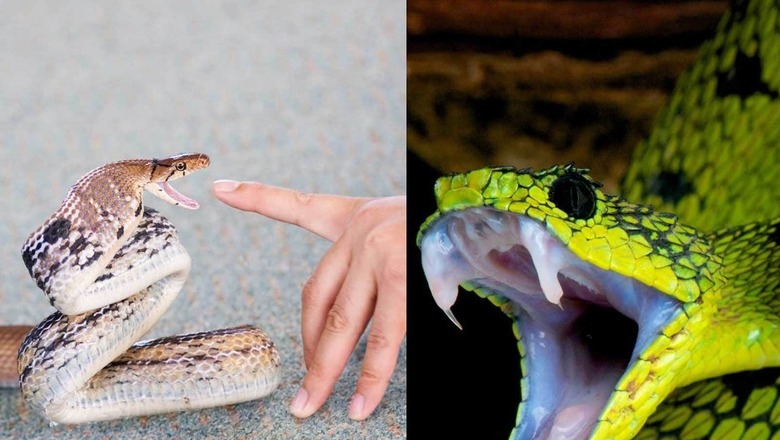Snakebite a ‘Disease’ of Poverty: ICMR Has a Plan to Help WHO Achieve Its Goal to Cut Deaths by Half

views
Posters, cartoon messages, videos on prevention and first aid — the Indian Council of Medical Research (ICMR) is ready with the plan to achieve the World Health Organization’s (WHO) goal to cut down snakebite deaths to half by 2030.
India’s apex health research institute has published the National Snakebite Project protocol aiming for community empowerment and capacity building of the public healthcare system to prevent and manage snakebite envenomation.
ICMR’s the National Institute for Research in Reproductive and Child Health (NIRRH) has begun a study in Maharashtra and Odisha.
Snakebite envenoming (SBE) is one of the neglected tropical diseases (NTD) leading to around 81,410 to 137,880 deaths from 1.8 million to 2.7 million cases globally.
According to the latest national mortality survey, India had 1.2 million snakebite deaths (average of 58,000 per year) from 2000 to 2019, which is an increase of about 8,000 cases per year compared to the earlier estimated survey (2001-2003).
However, only a 10% coverage of the actual snakebite burden being captured in the government data in Maharashtra was also reported indicating gross underestimation of morbidity and mortality in Maharashtra.
The majority of the deaths occurred at home in rural areas with half of the deaths happening between 30-69 years of age.
Eight states (Madhya Pradesh, Odisha, Uttar Pradesh, Bihar, Jharkhand, Rajasthan, Gujarat, and Andhra Pradesh including Telangana) of India shared the burden of about 70% of snakebite deaths from 2001 to 2014.
WHO classified SBE as a high-priority neglected tropical disease (NTD) in 2017, and subsequently, in May 2018, 71st World Health Assembly adopted a resolution providing a strong mandate to WHO for global actions on reducing the burden of SBE.
Framework of the Study
The study has been conceptualised by Dr Rahul K Gajbhiye, a scientist at NIRRH-ICMR, whose team used the experiences from the retrospective study at a sub-district hospital in Dahanu, Maharashtra.
SBE is labelled as the ‘disease of poverty’.
The planned study will be divided into five phases, the protocol uploaded on PLOS-ONE, a peer-reviewed open-access scientific journal.
The two-year implementation research involves collecting retrospective data, facility assessment for snakebite management preparedness, training of medical officers, interviews of healthcare workers, post-training prospective data collection and evaluation of the interventions to assess their impact.
For instance, retrospective data collection and facility surveys will be conducted in the first phase. “Two-year retrospective data (January 1, 2020 to December 31, 2021) will be collected from all the public health facilities in study areas where snakebite management is expected to be provided,” the protocol said.
In the second phase, the development and implementation of an educational intervention will be conducted.
Educational interventions in the form of printed IEC material will be developed based on the gaps identified during the focused group discussions in phase one. IEC stands for information, education and communication.
According to the protocol, commonly occurring words in the local language along with pictorial/cartoon messages will be used in the IEC material. Videos regarding the immediate care of a snakebite victim at the facility will be circulated among healthcare providers.
Informative posters would also be put up at places where people gather routinely like tea stalls or local restaurants.
In the third phase, an evaluation of the healthcare providers will be undertaken.
“Assessment of the basic knowledge, awareness, and perceptions on snakebite management and prevention among healthcare providers will be conducted,” the protocol said.
All the medical officers and peripheral health workers from the study blocks who agree to participate will be included in the study.
The fourth phase will be the capacity building of healthcare providers through periodic short-term training programmes. A team of national experts for snakebite management will provide training to master trainers at each study site.
The training will involve lectures and practical demonstrations to cover all aspects of snakebite management including signs and symptoms of SBE, how to suspect or recognise snakebite, management of severe cases, anti-venom use, laboratory examinations, referral and discharge criteria, according to the protocol.
In the last and fifth phase, impact evaluation of interventions will be conducted.
For instance, the impact of capacity building on the healthcare system will be assessed by comparing prospective data with retrospective (pre-intervention) data.
The authors of the protocol believe that from the community’s point of view, preventing life-threatening snakebite incidences is the holy grail.
According to the authors, simple measures such as the use of bed-net while sleeping, a torch and stick while walking in the dark, not going out for defecation, using knee-length footwear in the farm can help prevent snakebites.
“Encouraging community participation, healthcare provider empowerment, and wide-scale IEC activities are the strengths of the study,” the authors said while adding that “the national snakebite project will use a multi-sectoral, multi-stakeholder approach to reduce the burden of SBE.”
Read all the Latest India News here




















Comments
0 comment